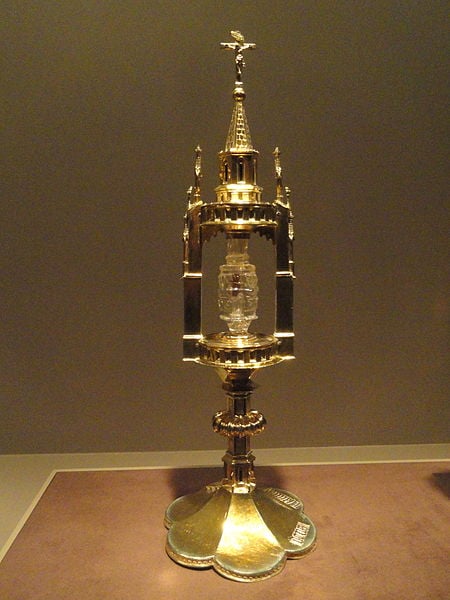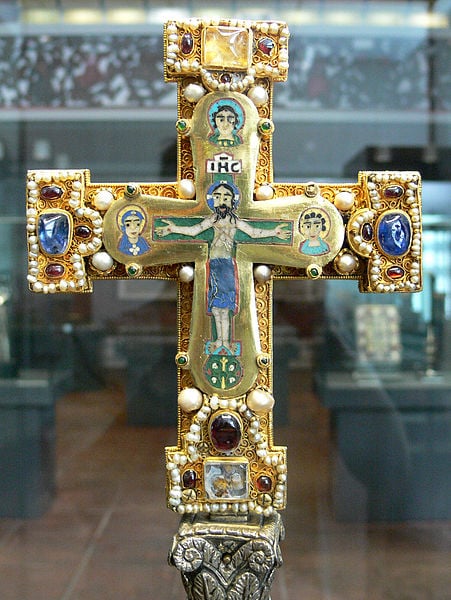One of the issues exposed and exacerbated by the ongoing Gurlitt collection stalemate is the question of Germany’s restitution procedures with respect to art. As the Bavarian legislative proposal to abolish the statute of limitations for claims against bad-faith acquirers is considered by the Bundestag, the “German Advisory Commission for the Return of Cultural Property Seized as a Result of Nazi Persecution, Especially Jewish Property” has issued a decision over what has become known as the “Guelph Treasure” (Welfenschatz) in the collection of the Stiftung Preussischer Kulturbesitz (SPK), the Prussian Cultural Heritage Foundation. The March 20, 2014 opinion (available, so far as I know, only in German at this point at www.lostart.de) underscores the issues around claims of sales under duress, and the appropriate present-day procedural remedy. Readers should also brush up on their medieval German history to keep up. 
The case attracted much attention before the decision, and the reaction has been one largely of dissatisfaction. As much as anything, the criticism has argued the need for a national claims process in Germany (perhaps like Austria’s). At first blush, the decision would seem to highlight exactly such a problem. But in the execution, would it be any different? Compare, for example, the Gustav Klimt’s Portrait of Amalie Zuckerkandl, exhibited last year in London amid controversy and the subject of an earlier Austrian arbitration. As with the Zuckerkandl Klimt, there was a reasonably robust hearing that concluded that a Nazi-era sale was an arms’ length one, with which the unsuccessful claimants were understandably and vocally unhappy. Recall, however, that the Zuckerkandl plaintiffs appealed the arbitration loss, which was confirmed by the Austrian Supreme Court. The point here is merely that even if the Commission were a binding arbitration process, the controversy might not have lessened, though a successful claimant would at least have the force of law. At least one other group of claimants unsuccessful before the Commission has also later won restitution in the German civil courts.
The case also highlights an uncomfortable analysis in restitution claims. It has long been accepted that a sale by a Jewish collector or another member of a group persecuted by the Nazis will be presumed to have been under duress, and rightly so. A presumption is not a fact, however. The question for debate is how, if ever, can that presumption be rebutted? Here, at least as the Commission presented the facts in its opinion, there was a collection acquired specifically for the purpose of sale, which was accomplished only in part because of the Great Depression during a period free from duress. It is certainly plausible that the difficulty in finding buyers for the remaining objects during the Nazi era was commercial, not political. But of course, it is similarly plausible that the market would have been artificially depressed by political actors. Here, the record seems incomplete—as it almost always will be.
The Advisory Commission, colloquially known as the Limbach Commission after member and former German Supreme Constitutional Court judge Jutta Limbach is an advisory committee that considers claims to such property in state possession. Unlike the process in, for example, Austria pursuant to its 1998 restitution law, the commission is not an arbitration, and it is not a judicial adjudication. It first sat in 2003, and has considered claims to property in state possession since, rendering recommendations on whether the state should return such property to claimants. So, for example the Commission recommended in 2005 that the German Federal Government restitute three paintings by Karl Blechen and a watercolor by Anselm Feuerbach to the heirs of Julius and Clara Freund. In 2008, it recommended that the German Land of Hessen pay Karl Ernst Baumann compensation amounting to 10,000 Euro for Portrait der Familie von Dithfurth by Johann J. August von der Embde. And in 2009, the Commission recommended that the German Federal Government return Peasant Girl without a Hat and with a White Headcloth (1897) by Wilhelm Leibl to the heirs of Dr Alexander Lewin. By contrast, in 2007 the Commission recommended against returning the poster collection of Hans Sachs that his heirs later won in court, language from the latter of which has been cited there and in the United States for the enunciation of German law on sales by Jewish collectors under duress.
In 2008, the heirs of four Jewish art dealers raised a claim to the Guelph Treasure. The names in this case are a reminder of the overlapping periods in German history: the collection consisted first of eighty two (82) sacramental objects and reliquaries from the 17th century collection of Braunschweig-Lüneburg (referred to in English as the Duchy of Brunswick and Lüneburg, a ducal state within the Holy Roman Empire and seat of one of the Electors of Hannover, known as Kurhannover). From a 1931 exhibition catalogue at the Fogg Art Museum at Harvard, the collection consisted of:
[R]eliquaries, crosses, portable altars, and other ecclesiastical objects. The earliest object in the collection was a cloisonné medallion, dating probably from the eighth century. The most significant of the objects date from the eleventh and twelfth centuries, a period of great artistic brilliance.
The Duchy (and other principalities) were ruled over the years by the House of Welf, known in English as the Guelphs, who played an important role in many chapters of the Holy Roman Empire, including Guelph and Holy Roman Emperor Otto IV (who was excommunicated, alas). After the dissolution of the Holy Roman Empire in 1806 and the Congress of Vienna in 1815, the Electorate became the Kingdom of Hanover (Königreich Hannover). For British history buffs, this will sound vaguely familiar—George I of England was the Duke of Brunswick-Lüneburg (Herzog von Braunschweig-Lüneburg), after which the duchy and the Crown of England remained in personal union until Queen Victoria in 1837.
The SPK is itself an odd hangover, heir to an entity that was an instrumentality of the Prussian government. Unlike many of the other Länder, Prussia was specifically and explicitly abolished by the occupying powers after WWII, and of course most of its territory either given to Russia and Poland, or subsumed in the DDR. In any event, the SPK retains oversight over significant collections today in the Berlin state museums, which are among the world’s finest.
In the 1920s, the Guelph heirs to the Electors were seeking to sell the collection. In October 1929—barely weeks before the beginning of the worldwide financial crisis that would become the Great Depression—they entered into a contract to sell the collection to a consortium of the shareholders of the dealers J.S. Goldschmidt, I. Rosenbaum, and Z.M. Hackenbroch. The agreement governing the consortium is lost, but the Commission’s decision recited the sale agreement itself, in which the consortium apparently pledged to seek to resell the collection and to share some part of those profits with the Guelphs. Specifically, the consortium promised that they were not entitled to retain the collection in whole or in part, but rather would “strive in every way to achieve the sale.”
In the years that followed, however, the art dealers attempted to sell the collection in its entirety, but were unable to do so during the worldwide economic crisis. Eventually they succeeded in the case of forty of the objects, which were sold for a combined price of 2.7 million Reichsmark (RM). After exhibiting the remaining forty two objects in the US (including at the Art Institute of Chicago), they were stored in Amsterdam.
In 1934, Dresdner Bank reached out to the art dealers to register interest. Unknown to the dealers, the bank was acting as agent for the State of Prussia. The consortium proposed initially a price of 5 million RM, to which the bank countered with 3.7 million RM. A contract for sale was eventually signed on June 14, 1935 with a sale price of 4.25 million RM—3,371,875 RM in cash, the remainder as the value of artworks given in exchange. Dresdner Bank signed for Prussia, but the Commission report does not make clear if Prussia was explicitly named as the buyer.
In any event, the Guelph Treasure remained with the SPK until the war was over, when it was seized by the occupying forces (presumably not only the Soviet Union, since it did not disappear east). It was entrusted first to the Land of Hessen, and then to Lower Saxony, until it was reclaimed in 1963 by the SPK, until these claimants asked for their return.
The claimants, in asking the SPK in 2008 to restitute the works, painted a different picture, or at least added what they felt were important details. As they pointed out, in 1934 and 1935 the German state was exerting enormous pressure on Jewish-owned businesses to relinquish their assets. Hermann Göring himself was the Prime Minister of Prussia at the time, and heavily engaged in the plundering of art he found desirable (of which these works would certainly have been the sort he often targeted). The price of 4.25 million RM, the claimants argued, was well below the market value of 6-7 million RM.
The SPK rejected the claim, noting in the first instance that the consortium had foreign shareholders who were co-owners of what was sold (presumably to contest the standing of these claimants). More centrally, the SPK pointed out that the sale was the intended outcome for the collection at the time of its acquisition in 1929, before the political pressure came to bear. Moreover, the SPK asserted, by 1934-35 there was no interest from others buyers, a reasonable explanation for which was the worldwide financial crisis, not political persecution.
Ultimately the Commission was persuaded by this last point, and recommended that the Guelph Treasure stay where it is. As the report noted:
Although the Commission is aware of the severe fate of art dealers and their persecution in the Nazi era, there are no indications that suggest that the art dealers and their business partners in the case to be assessed by the Commission were under duress—even from Göring; in addition, one had to deal with the effects of the global economic crisis in 1934/1935.
The Commission also stressed the availability of the sale proceeds at the time to the dealer as evidence that the sale was a commercial transaction, not a forced sale.
As a result of these findings, the Advisory Commission is of the belief that the sale of the Guelph Treasure was not a persecution-induced forced sale. It therefore cannot recommend a return of the Guelph Treasure to the heirs of the four art dealers and any other former co-owners.
There is no specific procedural recourse, so it remains to be seen now if civil claims will follow—as they did successfully for the Hans Sachs heirs. Given the use of the property itself in the United States in 1931, it could well be that they would be brought here under the Foreign Sovereign Immunities Act. Our next post will address a recent decision in the Second Circuit applying the Act of State doctrine that raises still more hurdles to such claims, however. Stay tuned….






